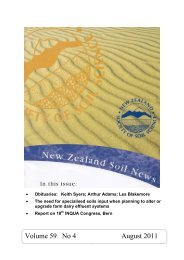Volume 55 No 2 April 2007 - New Zealand Society of Soil Science
Volume 55 No 2 April 2007 - New Zealand Society of Soil Science
Volume 55 No 2 April 2007 - New Zealand Society of Soil Science
You also want an ePaper? Increase the reach of your titles
YUMPU automatically turns print PDFs into web optimized ePapers that Google loves.
A history <strong>of</strong> soil survey and selected aspects <strong>of</strong><br />
soil conservation in <strong>New</strong> <strong>Zealand</strong><br />
Part one<br />
Dr P.J. Tonkin<br />
Senior Fellow<br />
Department <strong>of</strong> Geological <strong>Science</strong><br />
University <strong>of</strong> Canterbury.<br />
Email <br />
The gardeners from the Pacific<br />
Maori migrated from tropical Oceania to temperate Aotearoa where their gardeners had to discover<br />
soils suited to growing kumara, taro, yam, and gourd. Some soils were modified to improve growing<br />
conditions. <strong>No</strong>rthern areas had familiar reddish brown soils formed on weathered volcanic ash and<br />
scoria and volcanic rocks. Fertile and well-drained soils on flat to rolling country were <strong>of</strong> great<br />
importance. Elsden Best lists Maori names used to distinguish soils emphasizing soil colour and<br />
texture, soil fertility, ease <strong>of</strong> cultivation and drainage conditions. Examples are: Tuatara wawata<br />
(brown friable fertile, suitable for kumara), One paraumu (very dark fertile friable), One kura (reddish<br />
poor), Kerematua (stiff clay) and One kopuru (wet situations).<br />
The early colonial period<br />
Early European visitors to <strong>New</strong> <strong>Zealand</strong>, impressed by the lush forests, assumed erroneously they<br />
were growing on fertile soils. Dr Ernst Dieffenbach noted the geological origin <strong>of</strong> some soils in<br />
Chatham Islands and in <strong>New</strong> <strong>Zealand</strong>. Surveyors and missionaries recorded their impressions <strong>of</strong> soils<br />
under cultivation and by 1840 these observations were included in information for prospective<br />
colonists. The correlation <strong>of</strong> soil fertility with vegetation size, such as in the northern kauri forests,<br />
proved to be a fallacy leading to the adoption <strong>of</strong> specific plant indicators <strong>of</strong> soil fertility, such as puriri<br />
trees, said to be an indicator <strong>of</strong> fertile soils developed on basaltic tuffs in <strong>No</strong>rth Auckland.<br />
In the period 1840 to 1850, studies in United Kingdom and Europe <strong>of</strong> chemistry and plant nutrition,<br />
changed the approach to soil analysis. In <strong>New</strong> <strong>Zealand</strong> Europeans with geological knowledge made<br />
attempts to sample soils for analysis. These included Dr Ferdinand von Hochstetter when visiting<br />
Auckland Province in 1859. A geological survey, established in Otago by James Hector during the<br />
1860s gold rush, had a laboratory staffed by C.S. Wood and subsequently by William Skey. Hector<br />
moved to Wellington in 1865, establishing the Colonial Museum and Laboratory with Skey as<br />
Government analyst. Skey continued as Government analyst when he transferred to the Mines<br />
Department in 1893.<br />
A chemical approach to soil fertility<br />
Skey <strong>of</strong>fered free soil analyses, comparing results with standard works <strong>of</strong> the European chemist Justus<br />
von Liebig, and in 1868 reported analyses <strong>of</strong> 33 soils, giving texture, constituents soluble in water, and<br />
fairly complete analyses <strong>of</strong> hydrochloric acid extracts. This first was <strong>New</strong> <strong>Zealand</strong>s first chemical ‘soil<br />
survey’ and formed part <strong>of</strong> a suitability assessment <strong>of</strong> lands for European settlement. In 1900 Bernard<br />
C. Aston was appointed to the new Chemistry Division <strong>of</strong> the Department <strong>of</strong> Agriculture located in<br />
Wellington. He modified soil analysis in the light <strong>of</strong> an 1899 study <strong>of</strong> soils on the Taupo Plains. He<br />
advocated a systematic soil survey <strong>of</strong> <strong>New</strong> <strong>Zealand</strong>, and between 1903 and 1906 initiated a<br />
reconnaissance ‘flying soil survey’ combined with pot tests <strong>of</strong> soils to examine nutrient deficiencies.<br />
His aim was to identify, but not map, the predominant soil types <strong>of</strong> a district from a consideration <strong>of</strong><br />
climate and surface conditions, geological origin, physical and chemical characteristics, vegetation,<br />
and recognized economic adaptations. The soil in place, rather than in the laboratory, was Aston’s<br />
approach. Between 1908 and 1909, he modified the chemical methods for assessing plant available<br />
nutrients in the soil and with the co-operation <strong>of</strong> farmers, instituted a nation-wide series <strong>of</strong> soil fertility<br />
field experiments to a set design.<br />
The beginning <strong>of</strong> soil survey in <strong>New</strong> <strong>Zealand</strong><br />
In 1899 the United States Department <strong>of</strong> Agriculture (USDA) established the National Cooperative<br />
<strong>Soil</strong> Survey, the first government funded programme in the world. Initially the emphasis was on the<br />
soils assumed geological origins and the surface soil horizon. The first soil maps in the United States<br />
59










